


The fabric of our lives.
From ancient times to today, musicians have given us birthing songs and dying songs; feasting songs and songs for famine; songs for a day’s work and songs for a night’s sleep; and songs to be sung just for the joy of it. From the swell of pride that accompanies the singing of a national anthem to the sense of community from kindred spirits who know all of the words to a familiar campfire song, song is interwoven into the fabric of our lives. Each time we turn on the radio, plug into our iPods, attend a concert, or enjoy music in any of its other manifestations, we are participating in an ancient ritual.
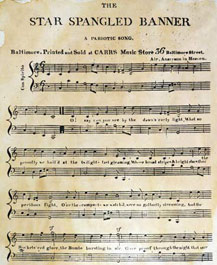
From the swell of pride that accompanies the singing of a national anthem to songs to be sung just for the joy of it, song is interwoven into the fabric of our lives.
| 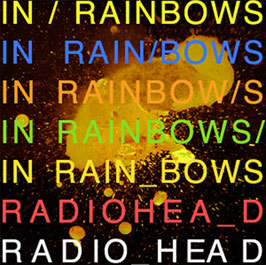
Today’s booming rock and hip-hop scenes offer a direct portal to ancient times, when shamans and elders used music as a method of oral storytelling.
|
A time portal.
Music and spoken word have been joined since ancient shamans and elders began using cadenced singing, drumming, and rhythmic dancing as forms of oral storytelling in order to communicate vital information to nomadic peoples. With their sense of tribalism, movement, performance, and the symbiotic relationship between lyrics and music, today’s booming rock and hip-hop scenes offer a direct portal into a time otherwise lost to the sands of history.
Virtually all ancient cultures – China, India, Persia, the Mesoamericas, Indo-Aryan, Egyptian, and Mesopotamian – used storytelling, with the presentations delivered by orators in song-verse as a way of feeding audiences huge amounts of material in bite-sized chunks.
Lyrical traditions.
The first written tributes – of Sumeria’s Enheduanna to the goddess Inanna, ancient Egyptian love poetics, India’s Vedas, China’s dynastic nature odes, and early Biblical-era works (such as Song of Songs, Psalms of David, and Song of Deborah) – were not poems as we know them, but lyrics, written to be sung.
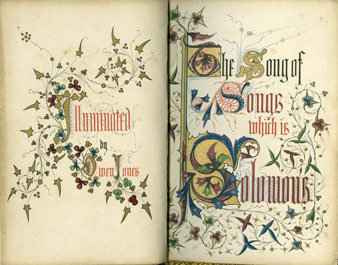
Early Biblical works like the Song of Songs were not poems, but lyrics that were written to be sung. (Owen Jones, Song of Songs which is Solomon's, 1849)
| 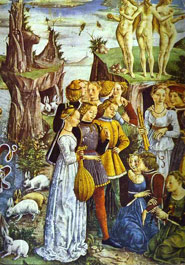
Poet-singers were the rock stars of the Middle Ages. (Francesco del Cosa, Triumph of Venus, 1470s)
|
This lyrical tradition informed and inspired the earliest Greeks. Their lyric poetry spoke to subjects of love, war and peace, nature and nostalgia, social issues, relationships with gods and goddesses, and grief and loss – subjects that feed virtually every lyric-based music genre today.
With the Middle Ages, music and poetry alike enjoyed a period of great prosperity and attention, a result of the burgeoning European feudal system that placed traveling poet-singers such as the troubadours and minstrels at the forefront of courtly living and made "rock stars" of those skilled with the pen, voice, harp, and flute. Provencal composer-poets like Marie de France, Adam de La Halle, and prolific composer Guillame de Machaut broke European prosody out of the iron cage of the Middle Ages by putting words to music through forms like rondeau, canso, madrigal and ballade, then fanning out to Spain, Italy, and England.
Domination, decline, & revival.
After the healthy boon of the Renaissance, lyric work dominated the poetry scene through the 16th and 17th centuries, finding champions in John Donne, Robert Herrick, Basho (in Japan), and others. After a decline in the 18th century, the Romantics embraced the idea of emotion over reason and revived lyric poetry as the ultimate expression of intense feeling. The early 20th century brought little change as lyric poetry dominated in both Europe and America. It was memorized by children in one-room schoolhouses, jotted onto Valentine’s cards, and quoted as often as one might hear their favorite song on the radio. Out of this love of lyric poetry, the parlor song emerged. Songs like "Home Sweet Home," "When the Swallows Homeward Fly," and "Beautiful Dreamer" were played and sung in homes in every region, regardless of social class.
Among others, John Donne championed lyric work in the 16th and 17th centuries.
| 
T.S. Elliot wrote this inscription to Ezra Pound. Both poets chose to focus on the grit of daily life. Pound’s work, The Cantos, reflects his affinity for troubadour poetry and song.
|
At the same time, a movement engineered by poets Ezra Pound, T.S. Elliot, and William Carlos Williams worked to reject what were considered to be the "vapid" notions of Romantic lyric poetry and focus instead on complexity and the grit of daily life. Despite an initial opposition to traditional lyricism, it was this particular poetic revolution that made way for the counterculture movement of the 1960s.
The old made new again.
The poetic lyrics of Bob Dylan, the Doors, the Byrds, and Joan Baez easily demonstrate the connection between the new and the old. From Baez’s rendition of Poe’s "Annabell Lee," to Dylan’s nods to T.S. Eliot and Ezra Pound (in "Desolation Row"), to the Byrds’ re-working of a verse from the biblical Book of Ecclesiastes ("Turn, Turn, Turn"), the troubadours of the musical revolution of the 1960s honored their forbears.
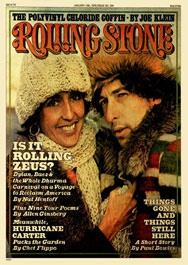
The poetic lyrics of Joan Baez, Bob Dylan, and others honored their forbears
| 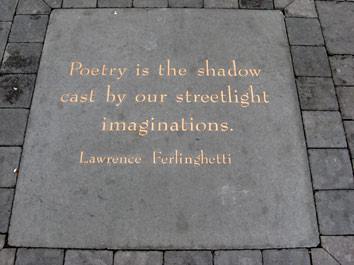
In the late 1960s, Lawrence Ferlinghetti and other poets would open rock concerts with spoken-word performances.
|
While the decade brought about a onslaught of new, cryptic, and appropriately unsettling lyrics, the era also saw a resurgence of old ballads of the medieval and Renaissance minstrels, such as "Barbara Allen," "Silver Dagger," and "Greensleeves." Indeed, the 1960s provide us with a palpable example of the marriage between "traditional" poetry and the poetry of song, with the lines blurred between the old and the new. So interconnected were poetry, performance art, and music in the late 1960s that poets such as Michael McClure, Lawrence Ferlinghetti, Gary Snyder, and Allen Ginsberg opened rock concerts and festivals with spoken-word performances.
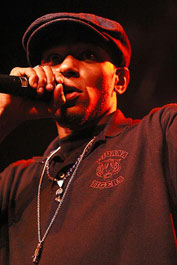
Mos Def and other rappers expounded upon socially relevant issues, much like poets in centuries prior.
Rap and hip-hop.
Forty years have passed since our latest major lyrical revolution, though many insurgencies have taken place since the 1960s. One of the most hard-hitting is rap, which arose from the inner-city social unrest of the '60s. After germinating in the 1970s, rap broke onto the scene in a big way in the 1980s, finding an audience among black youth and white Generation Xers burned out on a punk rock scene that had de-fanged into New Wave.
Characterized by meticulously rhymed, brutally frank lyrics expounding upon social injustice, sex, drugs, abuse, and poverty, and most often set to a driving beat with little instrumentation, rap lyrics have become the poetic battle cry of those angered by the world around them. By the late 1990s, rap artists shifted their focus from socially conscious lyrics to a tough "gangsta" approach. White youth jumped on the fan base in droves, with Detroit artist Eminem (Marshall Mathers) joining Dr. Dre, Mos Def, Puff Daddy, The Roots, Lauryn Hill, Missy Elliott, and others in lyrically expounding upon the issues that bothered them – much like what Blake was doing on the streets of London two centuries prior.
Future revolutions.
Only time will tell what the next decades may bring for the genre. While rap emerged as an entirely new genre out of the 1960s, most modern lyrics are an extension of what came before, with country, folk, rock, punk, indie, and New Age lyricists adjusting their styles to fit the times. As we head full-force into this millennium with new wars, new threats, new social mores, new concerns, and new celebrations, we may yet be ripe for a new poetic revolution, with song leading the way as the past, present, and future of poetry.
Become a performance poet.
Never has the songwriting market been larger or more diverse. Songwriters are the performance poets of the 21st century, celebrated – or reviled – as heartily as were the Beat poets of the 1950s or the Romantics of the late 18th and early 19th centuries. With an incredible variety of distribution outlets – and the viral marketing effect of the Internet – it pays to know how to write a song. Besides, the pleasure of having written a song knows few equals in creative expression.

As a teenager, Suzanne Vega used a songwriting formula that began with matching guitar chords to her mood.
Start where it feels right.
Writing your own song lyrics doesn’t require anything more than the impetus to say something to the world.
Regardless of fame, fortune, or experience, getting started is often the most difficult part of an artistic undertaking. Singer and songwriter Roseanne Cash writes, "Those niggling questions about the specifics of writing – the order of creation, the source of inspiration, the parsing of individual truth and the wrestling of facts and the divergence of the two, are better left alone and in the realm of mystery, where all creative work forms."
As a teenager, folk-pop music legend Suzanne Vega used a formula that began with matching guitar chords to her mood, then developing a melody, and finally writing the lyrics. She writes, "Each chord told a piece of a story, and by putting the chords together in a certain way you had a musical narrative. Major chords = happy. Minor chords = sad. Sevenths were sort of sexy and bluesy. Augmented and diminished chords were spooky and spiritual."
Songwriter Darrell Brown isn’t picky about where a song begins. He writes, "In general, it doesn’t matter to me if a title is the first thing to come out or the chord progression or any part of the melody or lyrics. I just want anything to come out so I can start writing (or the song can start writing itself)."
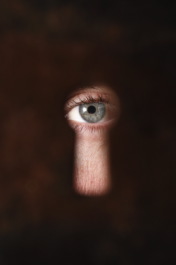
Darrell Brown says that songwriters are "emotional spies."
Ideas and inspirations.
Inspirations for lyrics come in many forms. According to Darell Brown, songwriters are "'emotional spies’ - little creative crazies creeping around, sneaking in and out of our own emotions, watching, listening and remembering every bit of conversation with friends, family and every stranger we meet." He writes, "If a song is cowering deep inside someone else’s divorce, engagement, seduction, innocence, sickness, recovery, treachery or resurrection, we long to see every crevice of it revealed in the light, all dressed up in grooves, chords and poetry."
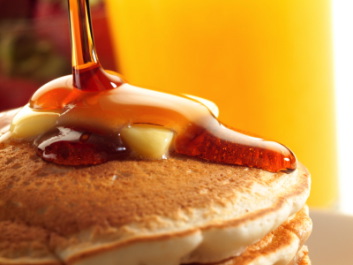
If you choose a title like "Pancakes on Sunday," the images it evokes will serve as the building blocks for your song.
Create a title.
Although you can begin the writing process with any component of a song – title, melody, or lyrics – for the purpose of this exercise, let’s start with the title. After you have this concise summary of what you want your song to be about, you’ll need to answer some questions. Answering questions is where your song begins. For instance, if you chose a title called, "Pancakes on Sunday," the questions you’ll need to answer are, "Who made the pancakes?", "Why on Sundays?", and "Why are the pancakes being made?" Once you answer these questions, images will flood your mind, and these images will serve as the building blocks for your song.
Think in images.
From the "sweet-apple reddening high on the branch," to the "stags stirring the river with their antlers," to "the milk-eyed mender," lasting lyrics have one common craft: they’re built on lasting images. Writing in too many abstractions (words that we cannot "see," such as love, hate, sad, happy, beautiful) is a common mistake made by budding writers. Instead, try to tell someone how much you love them (or hate them) by using images. What does this person do or say that makes you love them? Is it because they make you pancakes every Sunday in the shape of a flower? Then put that into your song. For the moment, don’t concern yourself with rhyming, verses, refrains, or choruses. Just list everything you "see" to shape your free-write into a song.

Singer and songwriter Roseanne Cash says that lyricists aren’t bound by facts.
Feelings over facts.
As you write, don’t worry about how closely your words conform to events in your life. Instead, let your inner poet soar. Roseanne Cash writes, "I used to teach a summer songwriting workshop, and sometimes I would suggest a change of a line or phrase in a song a fledgling writer brought to class and the writer would say, ‘But it didn’t happen that way.’ I would remind him or her that these were songs, not news reports, and if they were bound to just the facts, they should consider science rather than art."
Wail on it.
Not all songs have choruses, but most mainstream songs rely on a strong chorus that people will keep on singing. To give your song extra staying power, create a chorus that really drives your point home. Your chorus should be about four lines, and should be placed between the verses of your song. Your chorus should also contain some or all of the words in your title, to further reinforce your intentions. Go through the free-write you just composed and see if there are any images or ideas that stand out to you as being particularly powerful. Returning to the image of the pancakes, you can summarize the point of your song with a few lines about pancakes on Sunday:
You never brought me diamonds
Or jewels from far away
But you made me want you always
With your pancakes every Sunday
In writing a chorus, you’re giving the song shape by extracting one image that will, when the song is finished, unite all of the other images under a common theme, the theme here being that you love this person even if they couldn’t give you heaps of desirable riches.
Shape it up.
Now that you’ve got your chorus, it’s time to go back through your free-write again and see where the song is. If you feel as though there are multiple themes present in your free-write material, that’s wonderful! However, avoid loading your song with more than one or two main ideas or stories. Also, avoid confusing your listeners with ideas and images that are deeply personal to you, such as inside jokes, nicknames, or unexplained references to things and people. Begin creating an outline for your song – how the story will progress, which words you’d like to see in certain lines, and where your chorus will come in. Remember, your song must mean as much to other people as it means to you, so a second or third set of unbiased eyes as you’re putting your song together can be extremely helpful.
Once you’ve laid out the "bones" of your song, it’s time to lend it the shape that’s going to make it into a sing-able lyric. Since it’s far more difficult to imagine a song that doesn’t rhyme, work with a rhyme scheme for your first attempt. The important part about rhyming is that you should try to be as organic as possible; don’t force words to rhyme by using archaic syntax ("and sad I was made by your falling tears") and don’t try to cram too many syllables into one line for the sake of the rhyme. The best way to start out when learning to write with a rhyme scheme is to give yourself some leniency. Don’t insist on using an abab rhyme scheme. Instead, consider an abacor abcb rhyme scheme. That way, you only need to rhyme one pair of words per four-line stanza. We turn again to the "Pancake Song":
We met in August over wine and old bread (a)
At a cafe torn down in September (b)
So we stayed in on Sundays and you made us pancakes (c)
And I swore I would always remember (b)The syrup I kissed from your chin (d)
And the hiss of the pan on the fire (e)
But I forgot how they tasted, don’t remember your hands (f)
All I know now is hungry desire. (e)

Refining, editing, and polishing are all part of the songwriting process
Polishing a rough gem.
From start to finish, songwriting is a process that is both arduous and a great deal of fun. Keeping your vision for the song in mind and taking the time to listen to some of your favorite artists along the way will keep you inspired through the multiple revisions most songs require. Roseanne Cash writes, "Twenty-five years ago, I would have said that the bursts of inspiration, and the transcendent quality that came with them, were an emotionally superior experience, preferable to the watchmaker concentration required for the detail work of refining, editing and polishing. But the reverse is proving to be true. Like everything else, given enough time and the long perspective, the opposite of those things that we think define us slowly becomes equally valid, and sometimes more potent."
Remember that the success of your song lies in an equal balance of emotion and craft. If your song is all emotion, people may or may not understand what you’re trying to say. If your song is perfectly crafted but lacking in emotion, people will not care what you have to say. As you draft and redraft your blossoming lyrics, make sure to preserve your earlier drafts, as it is often something said pages ago that will end up sparking the next song you write.
![Sing it!]](http://www.webexhibits.org/poetry/imagesFolder/istock000000629900xsmall.jpg)
If you play an instrument, you can take a crack at composition
Sing it!
If you already play an instrument – especially the guitar or piano – now is the time to take a crack at composition. If you know your scales and some basic music theory, try composing a melody for your lyrics by imagining the kind of mood you want your song to evoke and going from there. Roseanne Cash writes that the melody can grow out of a song’s lyrics: "I’ve found that the melody is already inherent in the language, and if I pay close enough attention to the roundness of the vowels and the cadence of the words, I can tease the melody out of the words it is already woven into. I have found that continual referral back to the original "feeling tone" of the inspiration, the constant re-touching of that hum and cry, more important than the fireworks of its origin. I have learned to be steady in my course of love, or fear, or loneliness, rather than impulsive in its wasting, either lyrically or emotionally."
If you’re not a musician, try finding a musician who’s willing to help you out, or perhaps spend an evening at an open mic; coffee houses host open mic nights in small and large towns alike. You may just meet someone looking for new material. If you’ve written lyrics that you feel can stand on their own as poetry, then step up to the microphone and proudly read your song aloud. If it’s good enough, no one will miss the guitar. For the musically adept and disinclined alike, there are now many useful computer programs that can help you create back-up tracks for a song (such as Apple’s "Garage Band" or Finale Notepad). Finally, there’s absolutely nothing wrong with keeping your song all to yourself. Anyone can make up a tune, regardless of whether or not they can read music. Sing it in the shower, while you’re cooking dinner, or while you’re cleaning the house. Feel proud of your creation and newfound artistic ability.
The New York Times blog, Measure for Measure pulls back the curtain on the creative process of song writing.

No comments:
Post a Comment